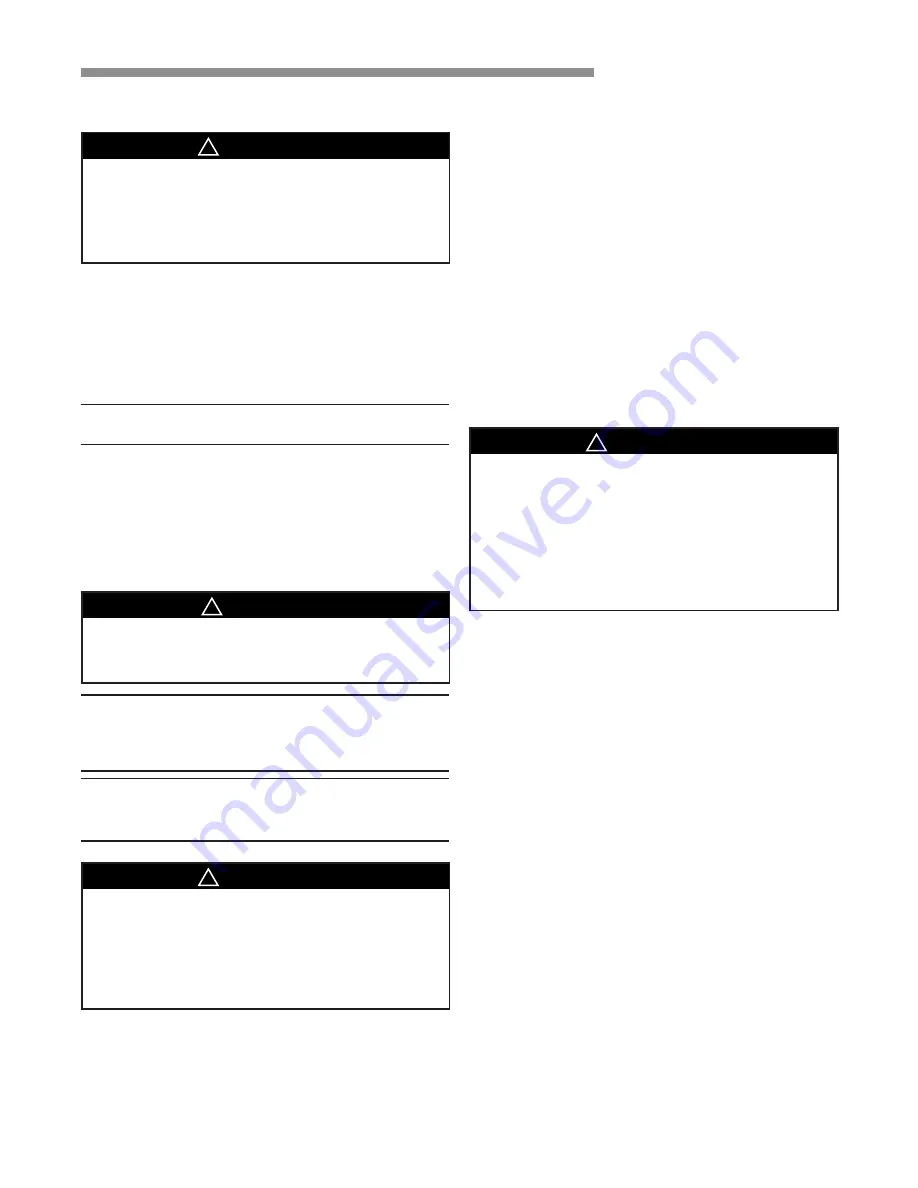
18-CD34D1-5-EN 17
INSTALLER’S GUIDE
that the pressure switch contacts are open and the limit switch(es)
contacts are closed, the draft blower will be energized.
As the induced draft blower comes up to speed, the pressure
switch contacts will close and the ignitor warm up period will
begin. The ignitor will heat for approx. 17 seconds, then the gas
valve is energized to permit gas flow to the burners. The flame
sensor confirms that ignition has been achieved within the 6
second ignition trial period.
After the flame sensor confirms that ignition has been achieved,
the delay fan ON period (fixed at 45 seconds) begins timing.
After the delay of 45 seconds, the indoor blower motor will be
energized and will continue to run during the heating cycle.
When the thermostat is satisfied, R and W thermostat contacts
open, the gas valve will close, the flames will extinguish, and the
induced draft blower will be de-energized. The indoor blower
motor will continue to run for the fan off period (fixed at 100
seconds), then will be de-energized by the control module.
▲
WARNING
!
FIRE OR EXPLOSION HAZARD
Failure to follow the safety warnings exactly could
result in serious injury, death or property damage.
Never test for gas leaks with an open flame. Use a
commercially available soap solution made specifically
for the detection of leaks to check all connections. A
fire or explosion may result causing property damage,
personal injury, or loss of life
START-UP AND ADJUSTMENT
Preliminary Inspections
With gas and electrical power “OFF”
1.
Duct connections are properly sealed
2.
Filters are in place
3. Venting is properly assembled
4.
Blower door is in place
Turn knob on main gas valve within the unit to the “
OFF
”
position. Turn the external gas valve to “ON”. Purge the air from
the gas lines. After purging, check all gas connections for leaks
with a soapy solution –
DO NOT CHECK WITH AN OPEN
FLAME
. Allow 5 minutes for any gas that might have escaped
to dissipate. LP Gas, being heavier than air, may require forced
ventilation. Turn the knob on the gas valve in the unit to the
“ON” position.
COMBUSTION AND INPUT CHECK
1.
Make sure all gas appliances are off except furnace.
2.
Clock the gas meter with the furnace operating (determine
the dial rating of the meter) for one revolution.
3.
Match the “Sec” column in the gas flow (in cfh) Table 12
with the time clocked.
4.
Read “Flow” column opposite number of seconds
clocked.
GAS PIPING
▲
WARNING
!
FIRE - EXPLOSION HAZARD
DO NOT RUN FLEXIBLE GAS LINE THROUGH THE
FURNACE CABINET WALL. FAILURE TO FOLLOW
THIS WARNING COULD RESULT IN PROPERTY
DAMAGE, SERIOUS PERSONAL INJURY, OR DEATH.
This unit is shipped standard for left side installation of gas
piping. A piping cutout is also provided in the right side for an
alternate piping arrangement. The installation of piping shall
be in accordance with piping codes and the regulations of the
local gas company. Pipe joint compound must be resistant to the
chemical reaction with liquefied petroleum gases. Refer to piping
Table 9 for delivery sizes.
NOTE: Refer to local codes and the National Fuel Gas Code,
current edition, for gas pipe requirements.
The furnace and its individual shut-off valve must be disconnected
from the gas supply piping system during any pressure testing of
that system at test pressures in excess of 1/2 psig.
The furnace must be isolated from the gas supply piping by
closing its individual manual shut-off valve during any pressure
testing of the gas supply piping system at test pressures equal to
or less than 1/2 psig.
▲
CAUTION
!
Use a backup wrench on the gas valve when
installing gas piping to prevent damage to the gas
valve and manifold assembly.
NOTE: Maximum pressure to the gas valve for natural gas
is 13.8" W.C. Minimum pressure is 5.0" W.C. Maximum
pressure to the gas valve for propane is 13.8" W.C. Minimum
pressure is 11.0" W.C.
All gas fittings must be checked for leaks using a soapy
solution before lighting the furnace.
DO NOT CHECK WITH AN OPEN FLAME!
The following warning complies with the State of California law, Proposition 65.
▲
WARNING
!
HAZARDOUS GASES!
EXPOSURE TO FUEL SUBSTANCES OR BY
PRODUCTS OF INCOMPLETE FUEL COMBUSTION
IS BELIEVED BY THE STATE OF CALIFORNIA TO
CAUSE CANCER, BIRTH DEFECTS, OR OTHER
REPRODUCTIVE HARM.
SEQUENCE OF OPERATION
Thermostat call for heat
R and W thermostat contacts close signaling the control module
to run its self-check routine. After the control module has verified






































